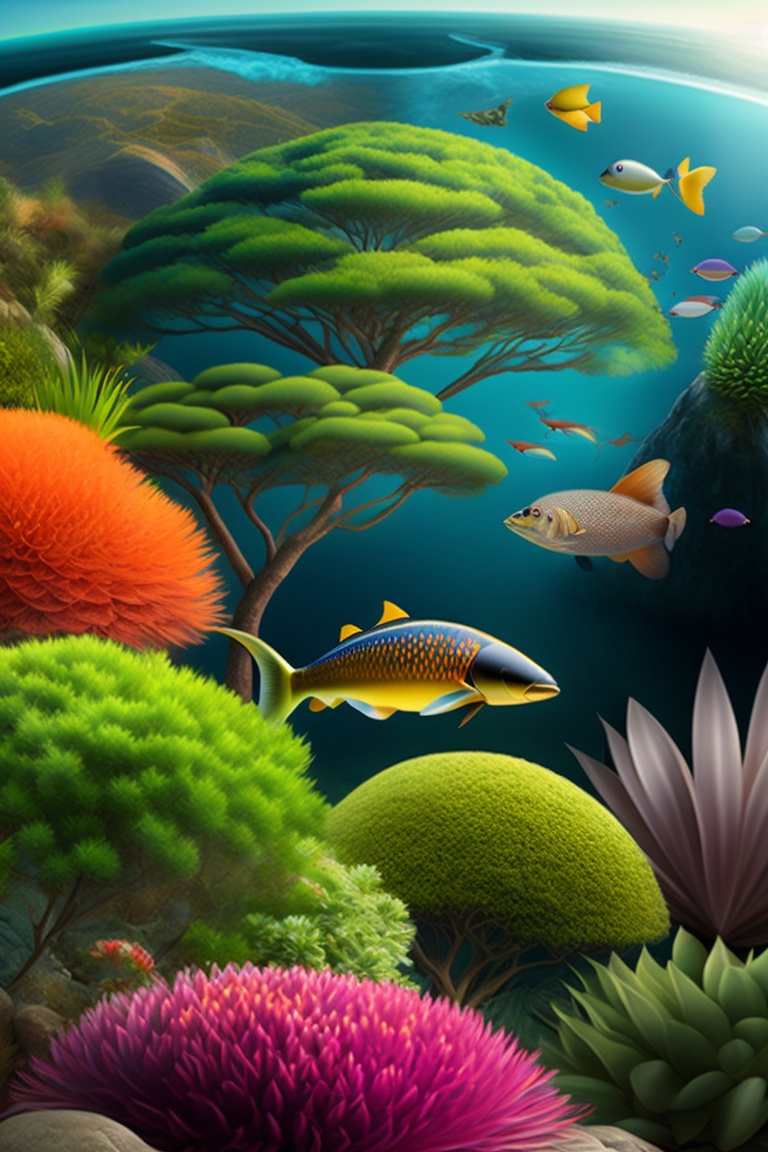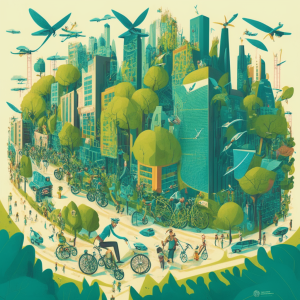Life on Earth is like an intricate tapestry woven with countless threads. Each thread represents a species, and together, they form a magnificent design – the priceless artifact known as biodiversity. But as our environmentalists passionately advocate, there’s more to biodiversity than just its aesthetic appeal. Why is biodiversity important? It forms the backbone of the ecosystems upon which we depend. Still skeptical? Hang on, let’s go on a journey to uncover the mystical marvels and imperative importance of biodiversity.
Why Is Biodiversity Important: An Overview
When you think of biodiversity, picture a gigantic, sprawling library. Each book represents a different species, each sentence a unique genetic code, and each word a unique trait. The library thrives on the sheer diversity of the books it houses, just like our planet thrives on biodiversity.
Biodiversity, in essence, refers to the vast spectrum of life forms that inhabit Earth – an extravaganza of species, each with their unique genetic makeup, all interacting within various ecosystems. From the microscopic bacteria aiding digestion in our gut to the majestic elephants roaming the African savannah, each is an invaluable participant in the grand spectacle of life.
What’s more, biodiversity also refers to the variety within species – what we call genetic diversity. It’s the reason why no two humans are exactly alike (except identical twins, but that’s a different story!). Genetic diversity is the secret behind the resiliency and adaptability of species. It is what makes the world of agriculture so rich – allowing us to enjoy hundreds of types of apples, tomatoes, wheat, and other crops.
Last but not least, biodiversity encompasses the variety of ecosystems – the beautifully unique settings where life unfolds. From the scorched deserts and the lush rainforests to the serene lakes and the mysterious deep seas, these diverse habitats each host a unique collection of life.
Why Should We Care About Biodiversity?
Biodiversity is to Earth what the immune system is to our bodies – a safeguard against the unforeseen, a provider of resilience and stability. Here’s why we need to pull out all stops to preserve it:
The Powerhouse of Ecosystem Services
Like the backstage crew in a theatre production, biodiversity operates behind the scenes, enabling life as we know it. It’s responsible for ‘ecosystem services,’ those essential functions nature performs that benefit humans.
From purifying air and water to enriching the soil and recycling nutrients, biodiversity is the life-support system of our planet. Remember the last time you enjoyed the sweet, juicy burst of a fresh strawberry? That was possible thanks to the ecosystem services of pollination and soil fertility, courtesy of biodiversity.
Supporting Human Health and Nutrition
Biodiversity is like the planet’s pantry, stocking a diverse array of foods that nourish us and keep us healthy. Imagine a world without the variety in your diet – it would be like living on bread and water!
Additionally, a vast number of medical discoveries have their roots in the natural world. For instance, the bark of willow trees gave us aspirin, while fungi gave us penicillin. Preserving biodiversity means keeping the doors open for future discoveries that could revolutionize healthcare.
Stabilizing Climate and Environment
Biodiversity is a key player in the game of climate regulation. Forests, oceans, and other ecosystems, teeming with life, absorb and store vast amounts of carbon dioxide, helping to mitigate climate change.
Wetlands, which are hotspots of biodiversity, act like giant sponges, soaking up water during floods and releasing it during droughts. Coral reefs and mangroves protect coastal communities from storm surges and tsunamis. Thus, biodiversity acts as a buffer against environmental disasters.
Protecting Our Economical Aspects
Economy and ecology are two sides of the same coin. Biodiversity underpins sectors like agriculture, fisheries, forestry, and tourism, which millions of people depend upon for their livelihoods.
For instance, genetic diversity in crops safeguards food security by preventing diseases or pests from wiping out an entire crop variety. Similarly, a diverse fish population ensures a stable and sustainable fishery industry.
Encouraging Scientific and Medical Discoveries
Each species is a warehouse of genetic information honed by millions of years of evolution. The study of these life forms, their interactions, and their adaptations has led to groundbreaking scientific and medical discoveries. Who knows, the cure for cancer might be lurking in a yet-to-be-discovered plant in a remote rainforest!
Why Is Biodiversity Important: The Threats
Biodiversity is akin to a complex web – pull on one string, and the entire structure can start to unravel. Currently, this delicate web is under severe strain due to various threats. Here, we delve into these threats in more detail:
Habitat Destruction and Fragmentation
Habitat destruction is the equivalent of bulldozing an entire city. As we expand our urban and agricultural land, we intrude on and often obliterate natural habitats. It’s estimated that we’ve modified over 75% of the Earth’s land surface, primarily through farming, urbanization, and mining, leaving little space for wildlife to thrive.
Take deforestation, for instance. Forests are biodiversity hotspots, teeming with myriad species. But in our quest for timber, agricultural land, and urban expansion, we’re rapidly clearing these lush ecosystems. The result? A dramatic drop in species diversity and abundance.
Similarly, wetlands – the kidneys of our planet – are being drained for agriculture, leaving waterfowl, amphibians, and countless other species homeless.
Fragmentation compounds the issue further. It breaks up continuous habitats into smaller, isolated patches, similar to turning a sprawling mansion into tiny, disjointed rooms. This fragmentation disrupts the movements and breeding patterns of wildlife and often leaves them stranded in ‘habitat islands’, too small to support viable populations.
Climate Change
Think of climate change as a hasty game of musical chairs that’s confusing many species. As temperatures rise, precipitation patterns shift and extreme weather events become more common, habitats change.
Species that can’t adapt or move quickly enough find themselves in a place that no longer suits their needs. For instance, polar bears are struggling to survive as melting sea ice reduces their hunting grounds. Likewise, many mountain species are being pushed towards higher, cooler altitudes, but eventually, they’ll run out of room to climb.
In marine ecosystems, rising sea temperatures and ocean acidification – both fallout of climate change – are wreaking havoc. Coral reefs, often referred to as the rainforests of the sea due to their incredible biodiversity, are particularly vulnerable. Increased sea temperatures lead to coral bleaching, a stress response that can kill corals and the vast array of species that depend on them.
Invasive Species and Overexploitation
Invasive species are like uninvited guests who outstay their welcome and create havoc. When species are introduced – intentionally or unintentionally – into new environments, they can outcompete native species for resources and alter habitats.
For example, the introduction of Nile perch into Lake Victoria in Africa led to the extinction of several native fish species. Similarly, in many parts of the world, invasive plants like water hyacinth and kudzu are out-competing native vegetation and transforming landscapes.
Overexploitation is another major culprit behind the biodiversity crisis. When we harvest plants, catch fish, or hunt animals faster than their populations can recover, it pushes them toward extinction. The passenger pigeon, once one of the most abundant birds in North America, was hunted to extinction in the 19th century. Today, overfishing threatens many fish species, while demand for animal parts like rhino horns and tiger bones fuels poaching.
In summary, our relentless assault on biodiversity is reshaping the living world as we know it, and the ramifications could be monumental. Not only does each lost species represent a loss of natural heritage, but it also disrupts the balance of ecosystems, potentially triggering a domino effect of environmental problems.
Why Is Biodiversity Important: Our Role
The decline in biodiversity is a challenge that requires collective action. While governments, organizations, and corporations have roles to play, individual actions can also make a significant impact. Here’s what you can do to contribute:
Conservation and Sustainability Practices
Creating and Managing Protected Areas
One of the most effective ways to conserve biodiversity is by creating and maintaining protected areas like national parks, marine reserves, and wildlife sanctuaries. While this is often a task for governments, citizen activism and public pressure can catalyze the establishment of these areas. By supporting legislation and initiatives that aim to protect natural habitats, you become a stakeholder in biodiversity conservation.
Restoring Degraded Habitats
Restoration of habitats like forests, wetlands, and grasslands can make a significant difference. You can contribute by volunteering for restoration projects or even initiating one in your local community. A well-restored habitat can be a haven for multiple species and provide a host of ecosystem services.
Legislation for Conservation
Laws and regulations are essential in protecting endangered species and fragile ecosystems. As an individual, you can advocate for strong environmental legislation by engaging with policymakers, signing petitions, and supporting organizations that lobby for conservation.
Adopting Sustainable Practices
Sustainable practices, on a personal level, can help minimize your impact on biodiversity. This includes making eco-friendly choices in your daily life, from the food you eat to the products you buy. It’s similar to choosing active transportation methods like walking or cycling over driving—each small decision adds up to a bigger impact.
Supporting Local and Indigenous Communities
Indigenous and local communities have deep-rooted relationships with their natural environments. Their sustainable practices and traditional knowledge offer valuable insights into biodiversity conservation.
Land Rights
Supporting the land rights of these communities can help in conserving large areas of biodiverse habitats. This can be done by advocating for laws that recognize indigenous land ownership and by financially supporting organizations that fight for these rights.
Traditional Wisdom in Policy
Incorporating indigenous and local knowledge into biodiversity conservation strategies can provide effective and culturally sensitive solutions. This can include methods of sustainable farming, forestry, or wildlife management that have been practiced for generations.
Promoting Responsible Consumerism
As consumers, our buying decisions have far-reaching implications on the environment. By consciously choosing products that are sustainably sourced and responsibly produced, we can incentivize businesses to adopt biodiversity-friendly practices.
Sustainable Sourcing
Look for certifications like Fair Trade, Rainforest Alliance, or Marine Stewardship Council when shopping. These labels often indicate that the product has met certain environmental and social standards.
Voting with Your Wallet
Think of each purchase as a vote for the kind of world you want to see. By prioritizing companies that take biodiversity conservation seriously, you are contributing to a market that values sustainable practices.
In summary, each one of us has the power to contribute to biodiversity conservation in multiple ways. By adopting sustainable practices, supporting local and indigenous communities, and making responsible consumer choices, we can each play a part in preserving the rich tapestry of life on Earth.
The Impact of Losing Biodiversity: A Stark Reality
Destabilizing Ecosystems
One of the most immediate consequences of losing biodiversity is the destabilization of ecosystems. When we lose species, we lose the intricate interactions that help maintain ecological balance. For instance, losing a predator can lead to an overpopulation of prey species, which may then overgraze and deplete vegetation, eventually causing soil erosion.
Disrupting Food Chains
Biodiversity is essential in establishing food webs and nutrient cycles. Removing even a single species can set off a domino effect throughout the food chain. This could lead to the overpopulation of certain organisms and the extinction of others, eventually disturbing the harmony of the ecosystem.
Jeopardizing Ecosystem Services
Humans rely heavily on what we term “ecosystem services,” which are the tangible and intangible benefits we receive from nature. This includes everything from clean water and air to mental well-being. Loss of biodiversity can severely impair these ecosystem services, affecting our quality of life and economic stability.
Spurring the Spread of Diseases
Biodiversity can act as a natural barrier to disease spread. For example, in a diverse ecosystem, a virus or parasite may have multiple hosts, diluting the disease’s impact. Reduced biodiversity can make it easier for diseases to spread rapidly, increasing risks to both human and animal health.
Amplifying Climate Change Effects
Biodiversity loss can exacerbate the impacts of climate change. For instance, deforestation not only results in the loss of species but also decreases the planet’s capacity to absorb carbon dioxide. This creates a feedback loop, as climate change can further endanger species, leading to even more biodiversity loss.
Economic Repercussions
The economic costs of biodiversity loss can be staggering. Reduced crop yields, failed fisheries, and diminished tourism are just a few examples. Such impacts can have cascading effects on communities that rely on these sectors for their livelihoods, leading to poverty and social unrest.
Losing the Soul of the Planet
Finally, the loss of biodiversity goes beyond just practical considerations. Each species lost is a piece of Earth’s natural heritage that vanishes. It’s akin to losing the soul of our planet, affecting our emotional and spiritual connection with the natural world.
In conclusion, the stakes couldn’t be higher. Each thread pulled from the tapestry of life not only distorts but risks tearing apart the fabric of ecosystems that sustain us. The loss of biodiversity isn’t just an environmental issue; it’s a crisis that affects every facet of human existence.
Conclusion: Why Is Biodiversity Important?
A Symphony of Life
Why is biodiversity important? Imagine nature as an intricate symphony, with each species representing a unique musical note. Together, they create a melody that has been finely tuned over millions of years. Biodiversity is this symphony, a complex masterpiece woven by evolution.
Nourishment and Inspiration
Biodiversity is not just a collection of different species; it’s the very basis of our life-support systems. It provides us with food, medicine, and materials. It also fuels our imagination and culture, inspiring art, music, and even religion. From the food on our plates to the air we breathe, biodiversity plays a vital role in sustaining life.
A Web of Life
In the grander scale of things, biodiversity enriches us by connecting all forms of life in an intricate web. This web reminds us that we are part of nature, not a separate entity. When we protect biodiversity, we are essentially recognizing our interconnectedness with the natural world.
Saving Ourselves
The urgency to protect biodiversity extends beyond saving charismatic species like whales or pandas. It’s a matter of self-preservation. Each species, no matter how insignificant it may seem, has a role in the ecosystem. The loss of any can disrupt these systems and, in turn, impact human life.
FAQs
Why Do Some Species Seem More Important in an Ecosystem?
Certain species have outsized impacts on their ecosystems, holding them together much like a keystone in an arch. These keystone species have roles that disproportionately affect the functioning and structure of their habitats. Removing a keystone species can unravel the threads of the ecosystem, leading to its collapse or significant alteration.
How Can Individuals Help in Conserving Biodiversity?
Conservation isn’t solely the responsibility of governments or organizations; individuals have significant roles to play. Simple actions like reducing waste, practicing recycling, and conserving water can make a difference. Additionally, planting native trees and plants can provide habitats for local wildlife. Supporting conservation organizations through donations or volunteering is another impactful way to contribute.
Does the Loss of Biodiversity Affect Humans Directly?
Absolutely, the loss of biodiversity can have tangible repercussions for humans. Reduced biodiversity can affect agricultural yields and jeopardize food security. It can also alter water cycles, potentially leading to water scarcity. Furthermore, loss of species can disrupt natural controls of pathogens, increasing disease risks. Finally, the socioeconomic consequences, such as reduced tourism and increased healthcare costs, can be profound.
What Is One of the Most Biodiverse Ecosystems in the World?
Tropical rainforests hold the title for being among the most biodiverse ecosystems globally. Despite covering less than 2% of the Earth’s surface, these jungles are home to more than half of the world’s species. They are a living library of genetic diversity, holding secrets that we have yet to discover.
What’s the Link Between Climate Change and Biodiversity Loss?
Climate change and biodiversity are intrinsically linked. Changes in temperature and weather patterns can force species to migrate, disrupt breeding seasons, and alter habitats, all contributing to biodiversity loss. Simultaneously, the loss of biodiversity can exacerbate climate change. Ecosystems like forests and wetlands act as carbon sinks, absorbing CO2 from the atmosphere. Their degradation releases stored carbon, amplifying the greenhouse effect.




